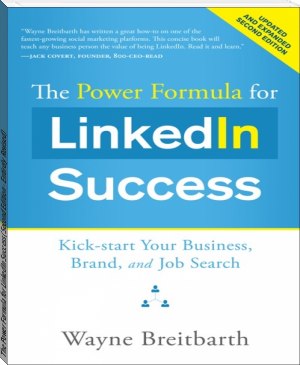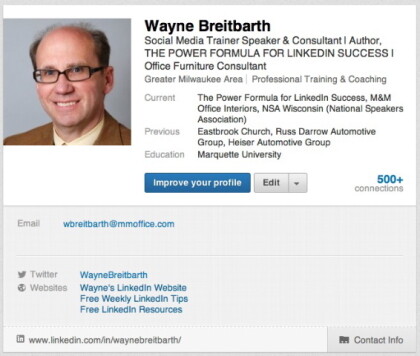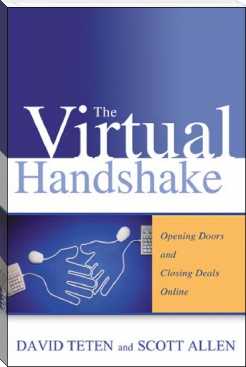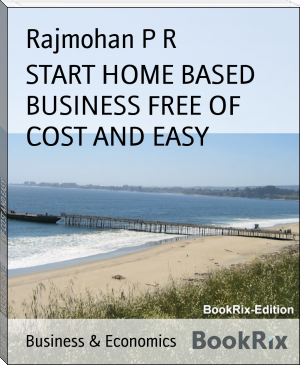The Power Formula for LinkedIn Success (Second Edition - Entirely Revised) by Wayne Breitbarth (children's ebooks free online TXT) 📖

- Author: Wayne Breitbarth
Book online «The Power Formula for LinkedIn Success (Second Edition - Entirely Revised) by Wayne Breitbarth (children's ebooks free online TXT) 📖». Author Wayne Breitbarth
The Power Formula for LinkedIn Success:
Kick-start Your Business, Brand, and Job Search
By Wayne Breitbarth
Chapter 3
Where’s the Beef?
The LinkedIn Profile: Basics
Everyone starts on LinkedIn with a profile. A profile can be as simple as your name. However, if you choose to list little but your name, you will be missing a tremendous opportunity to avail yourself of the two major benefits of a LinkedIn profile: the ability to be found and the opportunity to tell your story.
Plain and simple, profiles should be beefy. For those readers who are old enough, think of the Wendy’s commercial from the eighties in which the elderly ladies asked “Where’s the beef?” as they looked at a tiny hamburger patty dwarfed by a massive bun. For those of you who are not familiar with the commercial, check it out on YouTube. You’ll find it quite entertaining.
There are four reasons you want your profile to be beefy:
1.Your LinkedIn profile is a place where you can tell your story completely and fully, so that when people are looking at your profile, they will be encouraged to do business with you over your competitors. They will see the depth and breadth of your experience, your professional recommendations, and the brands you carry, plus your certifications, educational experience, and all the other qualifications you possess that make you the obvious professional to do business with in the marketplace you serve. I like to refer to a LinkedIn profile as a “resume on steroids.”
In contrast to a traditional resume, which is typically a listing of facts and dates, your LinkedIn profile allows you the opportunity to tell your story. It should be a narrative of sorts, where you emphasize your experience and high level of credibility. This “resume on steroids” should shout out “I’m the best at this in my market!”
To help tell your story, you can include details about yourself that, while perhaps bordering on personal information, will get across to the viewer who you are as a unique individual. For example, one of my class attendees told me that through the LinkedIn profile of a prospective client, he learned the guy collected wines—and he also found out which one was his favorite. On the day following his proposal presentation, he followed up with a thank-you note and included a bottle of—you guessed it—his prospective client’s favorite wine, and the rest is history. He got the order.
2. Every word in your profile is keyword searchable. Thus, having a beefy profile will increase your chances of being found. As you know from using Google, keyword searching on the Internet is an extremely powerful tool for finding people. Similarly, searching on LinkedIn can produce extremely valuable results. The search function enables you to find people who have certain types of experience, classifications, and/or brands. In subsequent chapters, I will address in detail how you can increase the likelihood of being found on LinkedIn by strategically including specific information and keywords in the various sections of your profile.
When I owned an office furniture dealership, I was looking for a person interested in bicycling to join a group of cyclists for a charity event my company was sponsoring. Discovering a bicycling enthusiast who happens to be an architect or builder would be a home run. I would then be able to advance a professional relationship, help a charitable organization, and enjoy a day of bicycling. Therefore, I searched the words builder, architect, cycling, and bicycling and instantly had my choice of architects and builders with whom to spend the day. Without those keywords in their profiles, none of these people would have been found. The power of searching is discussed in detail in Chapter 10.
3.A beefy profile shows that you are not a dinosaur. What do I mean by this? For those of us in the Baby Boomer generation, people tend to appreciate the experience we possess, but they are also interested in knowing whether we are keeping abreast of the latest trends in the business world, including social media. A beefy profile will demonstrate you are on top of current trends in your profession or occupation and you embrace technology. You are not a dinosaur.
4.You should expect your profile to regularly be compared with those of your competitors. Therefore, in order to gain a competitive advantage, you will want your profile to include a plethora of information, keywords, and details about who you are, what you hope to accomplish, and how you might be able to assist others.
Many savvy LinkedIn users will review a person’s profile before meeting with her for the first time. Personally, I always talk about common interests, mutual friends, or some other interesting fact I found on her profile before I jump into, “So, I hear you need some LinkedIn training.” Business professionals use their LinkedIn profiles to tell their stories. As a result, it can be extremely beneficial to review the profile of the potential customer, prospective employee, vendor, or other person with whom you desire to have a business relationship. Because of the vast amount of information available on the Internet in general and on LinkedIn in particular, it has become commonplace to “shop” several vendors online before engaging in direct communication.
Do yourself a favor and take a look at the profiles of some of your competitors. Observe what they are saying about themselves—awards they have won, certifications they hold, types of projects they have worked on, etc.—because this may jog your memory and remind you of similar information you could include in your profile. Based on the information contained in the profiles, would a potential customer be encouraged to do business with you as opposed to one of your competitors? If you think your competitor would get the nod, then start beefing up your profile.
Now that you know the reasons you want your profile to be beefy, the next several chapters will show you the steps to making sure you have all the necessary information on your profile.
Applying the Power Formula
It will be awfully hard for you to delegate the step of creating a beefy profile to someone else. No one knows your story like you do or can feel as passionate about why that story makes you the best at what you do. That passion will be evident if you personally craft a beefy profile that explains your unique experience.
Try not to turn your profile into a bunch of marketing gobbledygook. People want to read about what you have done in a simple, understandable format. You need to impress them with what you have accomplished, not with how many buzzwords you can include.
Start to assemble the details of your unique experience by reviewing all of your past jobs and awards, but do not wait to get going on this until you think you have it all together. Subsequent additions to your profile are not only fine but preferable. I will address that topic in more detail later in this book.
Chapter 4
Your 10-Second Bumper Sticker
The LinkedIn Profile: Personal Identification Box
The first item on your LinkedIn profile is what I like to refer to as your “top box” (see Figure 4.1). This box identifies you with several key pieces of information, including your name, headline, photograph, location, industry, experience, education, websites, and contact information. In this chapter I will address the three most prominent items—name, photo, and headline—because this information is used to identify you throughout the LinkedIn site. Some people will never go to your profile to look at the details, but they will see your personal identification box—what I like to refer to as your “10-second bumper sticker” (see Figure 4.2). Let’s address those components one at a time.
Figure 4.1: Your top box is front and center on your profile. Follow my guidelines and make a great first impression.

Figure 4.2: A businesslike photo and compelling headline will help you achieve maximum impact from your 10-second bumper sticker.

Your Name
This element is pretty self-explanatory. Your name should include nothing but your full name, unless you have high-level academic degrees or easily recognizable certifications, such as PhD, MD, CPA, and certain other high-level insurance classifications or nursing classifications, etc. Personally, I wouldn’t include designations on the level of an MBA.
Since there will undoubtedly be people who will only know them by their maiden names, some married women who have taken on their husband’s last name find it useful to list a maiden name in parentheses—for example, Susan (Jones) Cunningham. You can also list your maiden name, former name, or nickname on your profile by using the Former Name field. To access this, go to “Profile” on the top toolbar and choose “Edit Profile.” Click the pencil icon next to your name and fill in the box labeled “Former Name.” Then choose whether you want this name visible to only your first-level connections, your entire network, or everyone on LinkedIn. Your former name will only appear in LinkedIn searches—not searches done on Internet search engines.
Your Photograph
Most LinkedIn experts are in agreement on the importance of including a photograph in your profile, as well as the benefit of using a headshot (professionally taken or near professional quality) of yourself wearing business attire, smiling, and looking like a person with whom people would want to do business.
Let’s talk about why personal photographs are a hang-up for some people, especially members of the Baby Boomer generation. Plain and simple, we Baby Boomers are afraid to admit that we are in our fifties or sixties. Well, the reality is that you cannot hide behind the computer screen and pretend you are twenty-eight years old forever, and you surely are not going to be able to hide your age when you show up for the job interview or when you show up to collect the check for the order the customer placed after you found him on LinkedIn and put together the sale. So get over it!
Many times people will remember a face before they remember a name. I want to be the person people find on LinkedIn the day after they meet me at an event and say, “I really liked that bald LinkedIn guy. That’s the guy. I recognize him by his picture.” The person who recognizes you from your photo may be the one who leads you to your million-cubicle sale.
Your Headline
A basic headline consists of the company you work for and the position you hold there, but the headline field can contain 120 characters, and it is your opportunity to tell an abbreviated version of your story. In it, you will want to describe your experience and mention how you can help someone who sees your profile or 10-second bumper sticker. You can edit your headline by clicking the pencil icon next to your current headline.
For the first seven or eight months I was on LinkedIn, my headline read, “President and Owner, M&M Office Interiors, where we give you the space you want and the experience you deserve, and LinkedIn trainer.” “The space you want and the experience you deserve” is the tagline for the company I owned at the time. I loved my tagline. I paid a lot of money for my tagline. It was the result of very extensive research, and I definitely think it stands for the brand the company has in the marketplace.
However, as much as I loved my tagline and what it says, it did not clearly state that my number-one priority was selling





Comments (0)